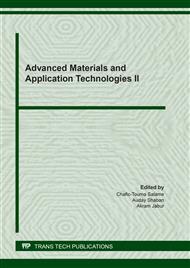[1]
R. A. Ganeev, Nonlinear Optical Properties of Materials. Springer, (2013). 89-98.
Google Scholar
[2]
T. A. Hamdalla and T. A. Hanafy, Optical properties studies for PVA/Gd, La, Er or Y chlorides based on structural modification,, Optik (Stuttg)., 127(2), (2016) 878–882.
DOI: 10.1016/j.ijleo.2015.10.187
Google Scholar
[3]
J. Messier, P. Prasad, and D. Ulrich, Nonlinear optical effects in organic polymers,Springer Science & Business Media,162 ( 2012).47-61.
Google Scholar
[4]
P. B. Bhargav, V. M. Mohan, A. K. Sharma, and V. V. R. N. Rao, Structural, electrical and optical characterization of pure and doped poly (vinyl alcohol)(PVA) polymer electrolyte films,, Int. J. Polym. Mater., vol. 56, no. 6, p.579–591, (2007).
DOI: 10.1080/00914030600972790
Google Scholar
[5]
R. N. Anderson, Materials science,, Wiley Encycl. Forensic Sci., (2009).23-26.
Google Scholar
[6]
M. A. S. M. Najeeb, K. A. Jasim, and N. N. Rammo, Structural properties different between two types of PE subjected to heat treatment,, in Journal of Physics: Conference Series, (2018), 1003(1), 12125.
DOI: 10.1088/1742-6596/1003/1/012125
Google Scholar
[7]
O. G. Abdullah and D. R. Saber, Optical absorption of polyvinyl alcohol films doped with nickel chloride,, in Applied Mechanics and materials, 2012, vol. 110, p.177–182.
DOI: 10.4028/www.scientific.net/amm.110-116.177
Google Scholar
[8]
R. J. Young and P. A. Lovell, Introduction to polymers. CRC press,(2011).9-12.
Google Scholar
[9]
V. Goodship and D. K. Jacobs, Polyvinyl alcohol: materials, processing and applications, vol. 16, no. 12. Smithers Rapra Technology, (2009) 8-12.
Google Scholar
[10]
R. Nangia, N. K. Shukla, and A. Sharma, Preparation, structural and dielectric properties of solution grown polyvinyl alcohol (PVA) film,, in IOP Conference Series: Materials Science and Engineering, 2017, vol. 225, no. 1, p.12044.
DOI: 10.1088/1757-899x/225/1/012044
Google Scholar
[11]
Z. W. Abdullah and Y. Dong, Polyvinyl Alcohol/Halloysite Nanotube Bionanocomposites as Biodegradable Packaging Materials., Springer, (2020) 1-50.
DOI: 10.1007/978-981-15-7356-9_1
Google Scholar
[12]
K. Qiu and A. N. Netravali, A composting study of membrane-like polyvinyl alcohol based resins and nanocomposites,, J. Polym. Environ..21( 3) (2013) 658–674.
DOI: 10.1007/s10924-013-0584-0
Google Scholar
[13]
E. Chiellini, A. Corti, S. D'Antone, and R. Solaro, Biodegradation of poly (vinyl alcohol) based materials,, Prog. Polym. Sci.28 (6), (2003), 963–1014.
DOI: 10.1016/s0079-6700(02)00149-1
Google Scholar
[14]
T. A. Germer, J. C. Zwinkels, and B. K. Tsai, Spectrophotometry: Accurate measurement of optical properties of materials. Elsevier, (2014) 26-28.
Google Scholar
[15]
S. Gorog, Ultraviolet-visible spectrophotometry in pharmaceutical analysis. CRC press, (2018) 40-43.
Google Scholar
[16]
K.-E. Peiponen, R. Myllylä, and A. V Priezzhev, Optical measurement techniques: Innovations for industry and the life sciences, Springer, vol. 136. (2009) 4-5.
Google Scholar
[17]
A. Mackenzie, BIOS Instant Notes in Mathematics and Statistics for Life Scientists. Taylor & Francis, (2004) 40-45.
Google Scholar
[18]
Bahjat B. Kadhim, Ridha H. Risan, Auday H. Shaban, Kareem A. Jasim, Electrical characteristics of nickel/ epoxy - Unsaturated polyester blend nanocomposites, AIP Conf. Proc. 2123, (2019), 020062-(1-5).
DOI: 10.1063/1.5116989
Google Scholar
[19]
M. R. Riazi, Characterization and properties of petroleum fractions, vol. 50. ASTM international, (2005) 329-330.
Google Scholar
[20]
D. M. Howard, J. Angus, Acoustics and psychoacoustics. Taylor & Francis, (2017) 267-268.
Google Scholar
[21]
B. Pajot and B. Clerjaud, Optical Absorption of Impurities and Defects in Semiconducting Crystals: Electronic Absorption of Deep Centres and Vibrational Spectra, vol. 169. Springer Science & Business Media, (2012) 42-44.
DOI: 10.1007/978-3-642-18018-7_5
Google Scholar
[22]
E. Bogatin, Signal integrity: simplified. Prentice Hall Professional, (2004) 16-21.
Google Scholar


